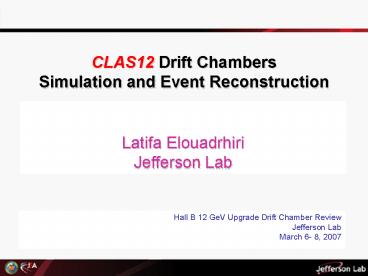CLAS12 Drift Chambers Simulation and Event Reconstruction PowerPoint PPT Presentation
1 / 30
Title: CLAS12 Drift Chambers Simulation and Event Reconstruction
1
CLAS12 Drift Chambers Simulation and Event
Reconstruction
Latifa Elouadrhiri Jefferson Lab
Hall B 12 GeV Upgrade Drift Chamber Review
Jefferson Lab March 6- 8, 2007
2
Outline
- CLAS12 Drift Chambers Requirements
- Luminosity Studies
- Two methods occupancy estimation, direct track
reconstruction - Results comparison of different methods
- Resolution p, ?, f
- Two methods linearized calculations, track
simulation and reconstruction - Results comparison of different methods
- Monte Carlo Simulation of Physics Reactions
3
CLAS12 Drift Chambers Requirements
R3
R2
R1
Arrangement of drift chambers in CLAS12
4
Background Situation at L1033cm-2s-1, DT 150ns
Drift ChambersR1
No Magnetic Field
5
Background Situation at L1035cm-2s-1, DT 150ns
No Magnetic Field
6
CLAS12 Single sector (exploded view)
CLAS 12 Solenoid provides magnetic field for
guiding Møller electrons away from detectors.
7
Solenoid Requirements
CLAS12
- Provide magnetic field for charged particle
tracking for CLAS12 in the polar angle range from
40o to 135o. - Provide magnetic field for guiding Møller
electrons away from detectors. - Allow operation of longitudinally polarized
target at magnetic fields of up to 5 Tesla, with
field in-homogeneity of ?B/B lt 10-4 in cylinder
of 5cm x 3cm. - Provide full coverage in azimuth for tracking.
- Sufficient space for particle identification
through time-of-flight measurements. - Minimize the stray field at the PMTs of the
Cerenkov Counter - Minimize the forces created by one magnet on the
other
CLAS12 Solenoid
8
Solenoid Requirements
CLAS12
- CLAS 12 Solenoid provides magnetic field for
guiding Møller electrons away from detectors.
9
Background Situation at L1035cm-2s-1, DT 150ns
No Magnetic Field
10
Background Situation at L1035cm-2s-1, DT 150ns
Electrons
Photons
One Event
with 5 T Magnetic Field
11
Møller Electrons in 5 Tesla Solenoid Field
Low Energy Moeller Electrons
Distance from the beam line in (cm)
0 20 40 60
80 z(cm)
12
Møller Electrons in 5 Tesla Solenoid Field
Mid-Energy Moeller Electrons
Distance from the beam line in (cm)
0 20 40 60
80 z(cm)
13
Møller Electrons in 5 Tesla Solenoid Field
High Energy Moeller Electrons
Møller Shield
Distance from the beam line in (cm)
0 20 40 60
80 z(cm)
14
Background Situation at L1035cm-2s-1, DT 150ns
Electrons
Photons
One Event
with 5T Magnetic Field
15
Background Situation at L1035cm-2s-1, DT 150ns
Electrons
Photons
Photons
One Event
One Event
Shielding
with 5 T Magnetic Field and Shielding
16
Background Event Generator
- The Event generator code DINREG
- Monte Carlo nuclear fragmentation event
generator, reproduces multiplicities and spectra
of secondary hadrons and nuclear fragments in
electro- and photonuclear reactions. - Generates events fully conserving 4-momentum,
baryon number and charge in the reaction. - Modified to include the electroproduction
processes in the energy range 2 - 10 GeV. - Has been used extensively at JLab for background
and shielding calculations.
17
CLAS12 Tracking Efficiency
18
CLAS12 Tracking Efficiency
19
CLAS12- DC Geant Simulation
DC R3
- Geant Simulation
- CLAS12 DC geometry
- magnetic fields
- Møller shield
- Upgrade of the event
- reconstruction code
Beamline Shielding
- Luminosity Studies
- Tracking efficiency
- DC occupancy
- Resolutions
- P, q, f
Solenoid Field
DC R1
DC R2
20
TORUS - Magnetic Field
CLAS12
Y(cm)
Y
Z
X (cm)
3 m
21
Solenoid-Torus Magnetic Field
CLAS12
Field in TORUS sector mid-plane
T 5o
10o
15o
B(Gauss)
B(Gauss)
B(Gauss)
35o
20o
30o
B(Gauss)
B(Gauss)
B(Gauss)
Z(cm)
22
CLAS12 Single Event Display
Low momentum track
5 degree angle particle
23
Simulations of tracking resolutions
- Use two methods MOMRES and RECSIS12
- MOMRES is a calculation of the change to p, q and
x due to multiple scattering at fixed locations
and due to finite spatial resolution - linearized approach - assumes small deviations
from ideal - applies to bend plane variables only
- RECSIS12 is based on the current CLAS tracking
program, upgraded with the correct CLAS12 DC
geometry - Includes pattern recognition, fit of tracklets
within single superlayers (solves left-right
ambiguities) using timing information. - Final track is fit globally (covariance matrix
includes multiple scattering). - Energy loss corrections after the global fit.
24
CLAS12 Momentum Resolution
25
CLAS12 Angular Resolution
26
CLAS12 Drift Chambers Resolution Summary
5o
- P resolution lt 1
- q resolution lt 1mrad
- X resolution lt 200 mm
27
CLAS12 Missing Mass Resolution
28
Missing Mass Techniques
CLAS12
ep ? eL(pp-)X
K
K(892)
29
Summary
- Drift Chamber system design parameters for the
CLAS12 detector are well defined. They were
developed based on - extensive detector simulation in realistic
background environment - direct track reconstruction in both solenoid and
Torus magnetic fields - extensive simulation of the physics processes of
the 12 GeV science program - The current design of the Drift Chambers in
combination of the Torus and solenoid design will
allow us to operate CLAS12 with L 1035 cm-2s-1
and achieve excellent resolution in p, q and f. - With these capabilities the CLAS12 will be able
to carry out a world-class experimental program
in fundamental nuclear physics.
30
Summary
- The magnetic configuration for the CLAS12
Detector are well defined. They were developed
based on - Extensive simulation of the physics processes of
the 12 GeV science program - Extensive detailed design and simulation of the
CLAS12 detectors that impact the magnet design - Optics of the High Threshold Cerenkov Counter
- Geometry of the Forward Silicon Detector
- Geometry and design of the Polarized target
- Extensive background simulations to calculate the
rates and radiation doses on the central
detectors (TOF and SVT) and on the forward
detectors (SVT, HTCC, Drift Chambers) to make
sure of the high luminosity capabilities.

